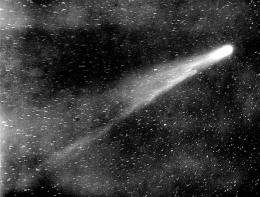A photograph of Halley's Comet taken during its 1910 approach. Image credit: The Yerkes Observatory / Wikipedia
(PhysOrg.com) -- Researchers have modeled the likely path taken by Halley's comet in the 5th century BC and compared their findings to ancient Greek texts from the period. They now suggest the ancient Greeks saw the comet, which would make the sightings over two centuries earlier than previous known observations.
Chinese astronomers first described the comet in 240 BC, but in ancient Greece in 466-467 BC Greek authors described a meteor the size of a wagon that crashed into the Hellespont region of northern Greece during daylight hours, frightening the population and creating a tourist attraction that lasted five centuries. The ancient authors describe a comet in the sky at the time.
Researchers Daniel Graham, a philosopher, and Eric Hintz, an astronomer, from Brigham Young University at Provo in Utah, compared their model of the comet’s likely path with the texts describing the meteor crash. Halley’s comet would have been visible for 82 days maximum, depending on atmospheric conditions at the time, while the ancient texts say the comet was visible for 75 days.
When the meteor fell, the comet was said to be in the western sky, and according to the model comet Halley would have been visible from 4 June to 25 August in 466 BC, and would have been in the western sky from July 18th. The comet was said to be accompanied by winds and shooting stars, and in July strong winds are common in the region. If the model is correct, at this time the Earth would have been moving under the comet’s tail, and shooting stars could have been created from its debris field.
According to Plutarch, writing in the 1st century AD, Anaxagoras, a young astronomer, had predicted the meteor crash, but this has puzzled historians because a meteor collision is a random event difficult to predict. Graham suggests Anaxagoras probably actually predicted that rocks might fall from the sky rather than a particular meteorite.
Anaxagoras made the prediction after observing the solar eclipse of 478 BC and concluding that heavenly bodies such as the moon were not lighter than air, as previously believed, but were actually made of rock. If nudged out of position, they could therefore crash to earth. It is possible that Halley’s comet could have nudged a small asteroid off course, and this was the meteor that hit northern Greece, but Dr Hintz is doubtful and said his feeling is that “it was just a really cool coincidence.”
Halley’s comet becomes visible to the unaided eye around every 75-6 years, but calculations of its appearance are difficult because sometimes its orbits bring it close to planets, whose gravity can change its course. The comet was named after the English astronomer Edmond Halley, who in 1705 correctly predicted the 1758 return of a comet that had previously been observed in 1682. The comet was last seen on 9th February 1986, and is expected to return in 2061.
More information: An Ancient Greek Sighting of Halley's Comet? Journal of Cosmology, 2010, Vol 9, 2130-2136. journalofcosmology.com/AncientAstronomy106.html
© 2010 PhysOrg.com






















